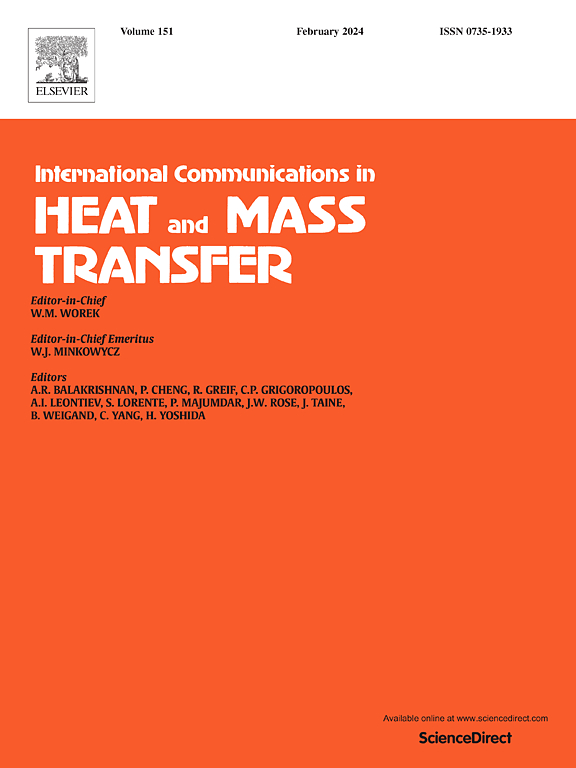具有壁结构和杂化润湿性的纳米通道内的流动沸腾
IF 6.4
2区 工程技术
Q1 MECHANICS
International Communications in Heat and Mass Transfer
Pub Date : 2025-08-06
DOI:10.1016/j.icheatmasstransfer.2025.109430
引用次数: 0
摘要
本研究采用分子动力学(MD)模拟研究了液态氩气在固体基质上的沸腾,重点研究了纳米结构和杂化润湿性对传热性能的影响。发现亲疏水杂化表面可以打破液体在壁面附近的规则流动模式,从而增强微对流效果。在光滑表面引入杂化润湿性比在纳米结构表面引入杂化润湿性更大程度上提高了平均热流密度,分别增加了28.6%和4.5%。对于光滑表面,疏水面积为35%的表面(A2)表现出更好的性能,平均热流密度最高,界面热阻最低,成核时间比完全亲水表面(A1)快680 ps。对于具有35%疏水面积(S3)的纳米结构表面,其中纳米柱的顶部和纳米孔的底部保持亲水性,表面表现出最佳的传热性能。其平均热流密度最高,界面热阻最低,成核时间比完全亲水光滑表面早1360ps。该研究揭示了纳米结构和润湿性在热管理系统中的潜在应用,并为优化沸腾传热提供了重要指导。本文章由计算机程序翻译,如有差异,请以英文原文为准。
Flow boiling in nanochannel with wall structure and hybrid wettability
This study employs molecular dynamics (MD) simulations to investigate liquid argon flow boiling on solid substrates, focusing on how nanostructures and hybrid wettability affect heat transfer performance. It is found that the hydrophilic/hydrophobic hybrid surface can break the liquid near the wall regular flow pattern, thus enhancing the micro convection effect. Hybrid wettability introduced on smooth surfaces improves the average heat flux to a greater extent than on nanostructured surfaces, with increases of 28.6 % and 4.5 %, respectively. For smooth surfaces, the one with 35 % hydrophobic area (A2) demonstrates superior performance, achieving the highest average heat flux and the lowest interfacial thermal resistance, and a nucleation time that is 680 ps faster nucleation time than the fully hydrophilic surface (A1). For nanostructured surfaces with 35 % hydrophobic area (S3), where the tops of the nanopillars and the bottoms of the nanocavities remain hydrophilic, the surface demonstrates optimal heat transfer performance. It achieves the highest average heat flux, the lowest interfacial thermal resistance, and a nucleation time that is 1360 ps earlier than that of a fully hydrophilic smooth surface. This study reveals the potential applications of nanostructures and wettability in thermal management systems and provides important guidance for optimizing boiling heat transfer.
求助全文
通过发布文献求助,成功后即可免费获取论文全文。
去求助
来源期刊
CiteScore
11.00
自引率
10.00%
发文量
648
审稿时长
32 days
期刊介绍:
International Communications in Heat and Mass Transfer serves as a world forum for the rapid dissemination of new ideas, new measurement techniques, preliminary findings of ongoing investigations, discussions, and criticisms in the field of heat and mass transfer. Two types of manuscript will be considered for publication: communications (short reports of new work or discussions of work which has already been published) and summaries (abstracts of reports, theses or manuscripts which are too long for publication in full). Together with its companion publication, International Journal of Heat and Mass Transfer, with which it shares the same Board of Editors, this journal is read by research workers and engineers throughout the world.

 求助内容:
求助内容: 应助结果提醒方式:
应助结果提醒方式:


